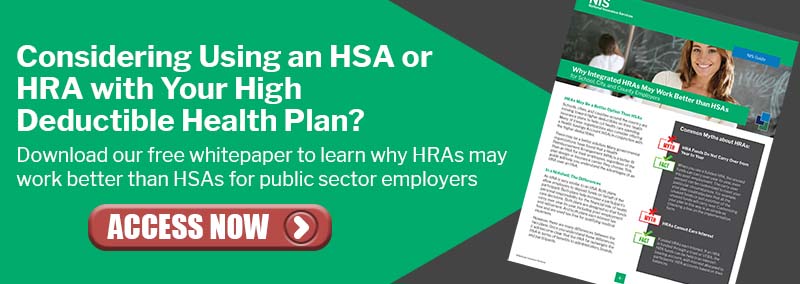2.5 minute read
Implementing any type of benefit change is usually met with a mix of openness and hesitation, depending on the employee. Many employers have implemented a Health Reimbursement Arrangement (HRA) to save on taxes, reduce their OPEB liability, and to help employees offset their increasing medical costs. Some employees may have some misconceptions about HRAs because they don’t understand the long-term benefits of this type of solution.
Receiving a cash benefit vs. depositing funds into an HRA
When an employee has unused sick leave or vacation pay, the employer could elect to give the employee a cash benefit or deposit the funds into an HRA.
With an HRA, the value of the benefit actually increases for the employee. The HRA is tax-free, so if the employer puts $30,000 into the employee’s HRA, then they will receive $30,000 and not a reduced amount. If FICA and federal taxes were taken out, they’d receive several thousand dollars less. All HRA deposits, reimbursements, and growth are tax-free.
| HRA | Cash Payout | |
| Benefit Amount | $30,000 | $30,000 |
| FICA Tax (7.65%) | Not applicable | - $2,295 |
| Federal Tax* | Not applicable | - $6,000 |
| Remaining Benefit Amount | $30,000 | $21,705 |
*Federal tax based upon 20%. Consult your tax advisor to see what your actual tax rate would be.
Spending funds after retirement
Some employees don’t think they will need to use their unused leave for medical expenses, as they would rather use the money for something else after retirement.
In 2019, the average retired couple at age 65 will need $285,000 to cover medical costs and health care in retirement.1 Without an HRA, retirees would likely use a tax-deferred cash payout or retirement benefit to cover medical expenses. HRA funds carry over year-to-year, earning tax-free interest. Early retirees can use the funds for health insurance premiums upon retirement.* The funds can also be used tax-free for qualifying medical expenses. To offset rising health care costs, using an HRA can maximize the value of their retiree’s unused leave.
HRA Beneficiary
Many believe that if an account holder passes away, any unused health funds are forfeited since HRAs for the most part do not allow beneficiaries to be designated; however, this is not totally true. After an employee’s death, a surviving spouse and dependents can still access HRA funds. The funds can be used to pay for their own qualifying medical expenses and eligible premiums.
For more information about HRAs, contact your NIS Representative.
*If the HRA is integrated with the employer-sponsored health insurance plan, funds can be rolled into a retiree-only plan and used for health insurance premiums during retirement.

